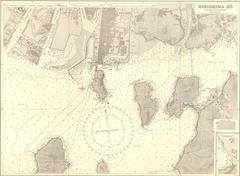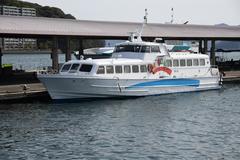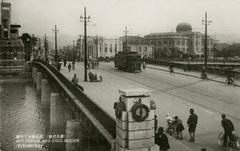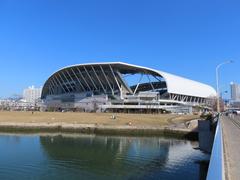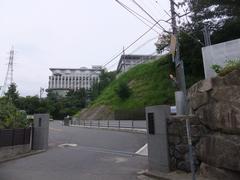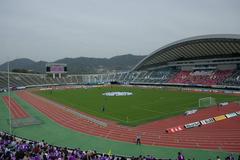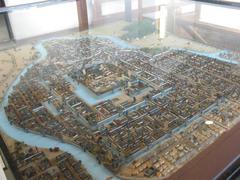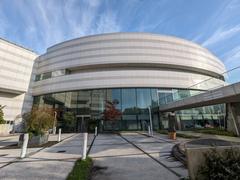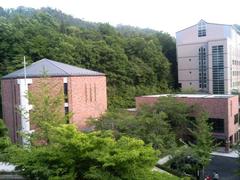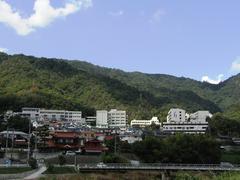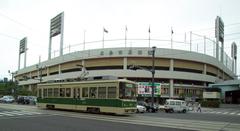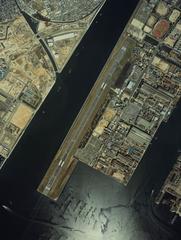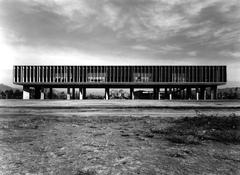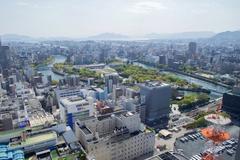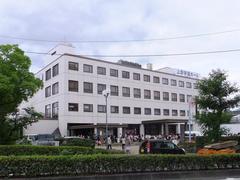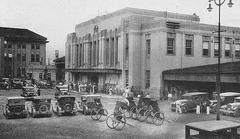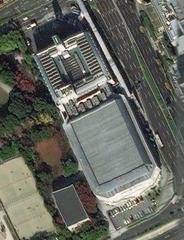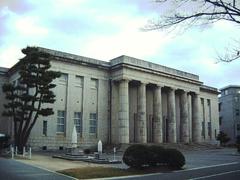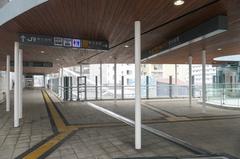
Hiroshima Port Visiting Guide: Hours, Tickets, and Nearby Attractions
Date: 14/06/2025
Introduction
Nestled along the Seto Inland Sea, Hiroshima Port is a modern maritime gateway seamlessly integrating centuries of history, resilient spirit, and vibrant urban culture. Since its establishment in the late 19th century, the port has played a pivotal role in Hiroshima’s transformation from a castle town into a global symbol of peace and progress. Today, it welcomes international cruise ships, domestic ferries, and travelers from around the world, serving as an ideal starting point for exploring Hiroshima’s iconic sites such as the Peace Memorial Park, Atomic Bomb Dome, and Miyajima Island (Japan Society; Wikipedia).
This guide provides detailed information on visiting hours, ticketing, transportation, accessibility, and the best attractions near Hiroshima Port—ensuring a smooth and enriching experience for every visitor.
Table of Contents
- Historical Overview
- Visitor Information
- Port Infrastructure and Terminals
- Passenger Services and Amenities
- Economic and Strategic Significance
- Role in Peace and Cultural Exchange
- Visitor Experience and Practical Tips
- Environmental and Urban Renewal Initiatives
- Culinary Experiences
- Cultural Activities and Guided Tours
- Outdoor and Side Trip Opportunities
- Shopping and Souvenirs
- FAQ
- Conclusion and Call to Action
Historical Overview
Early Foundations and Strategic Location
Hiroshima’s advantageous delta location on the Ōta River, facing the Seto Inland Sea, established it as a trade nexus and regional stronghold. Founded by the Mōri clan in the 16th century, the city’s strategic position facilitated economic growth during the Edo period, with the port supporting trade in rice, salt, and crafts (Japan Society).
Modernization and Industrial Expansion
The Meiji era brought significant modernization. The construction of Ujina Port (now Hiroshima Port) in the 1880s linked maritime and rail transport, fueling rapid industrialization. By the early 20th century, Hiroshima flourished as a manufacturing and commercial center (Japan Experience).
The Port’s Role in Empire and War
Ujina Port was crucial during Japan’s military campaigns in the late 19th and early 20th centuries, serving as a logistics base during the Sino-Japanese and Russo-Japanese wars. Expansion continued through the 1930s and 1940s, supporting both military and industrial activities (Japan Society).
The Atomic Bombing and Postwar Reconstruction
The atomic bombing of 1945 devastated Hiroshima and its port. Yet, leveraging its strategic location, the port was swiftly rebuilt, symbolizing Hiroshima’s resilience and its new mission as a city of peace. Modern infrastructure now supports both commercial and passenger operations (Japan Society; Wikipedia).
Visitor Information
Visiting Hours and Entry
- Port Access: Open 24/7 for commercial activity; public terminals and visitor areas usually operate from 6:00 AM to 10:00 PM. Cruise terminal facilities are often open from 8:00 AM to 6:00 PM, but check with your cruise line or ferry operator for specifics.
- Entry Fees: No entry fee is required to access the port area or terminals.
Tickets and Guided Tours
- Ferries to Miyajima: Tickets (approx. 180–360 yen one way) are available at the terminal or online. Ferries depart hourly, and schedules may vary seasonally.
- Attractions: Peace Memorial Museum (200 yen), Hiroshima Castle (370 yen), Shukkeien Garden (260 yen), and Itsukushima Shrine (300 yen).
- Guided Tours: Bookable through local operators, focusing on historical and cultural highlights. Some packages include attraction tickets (Japan Shore Excursions).
Accessibility
Hiroshima Port is equipped with ramps, elevators, and accessible restrooms. Shuttle buses, trams, and major attractions are all accessible for visitors with mobility challenges (Forever Karen).
Transportation
- Shuttle Buses: Free shuttles connect the port with Hiroshima Station and major terminals.
- Trams: The Hiroden streetcar system links the port to the city center and Peace Memorial Park (fares ¥190–270; coins required).
- Buses: Meipuru-pu sightseeing bus offers unlimited rides for a daily fee (¥400).
- Taxis: Readily available, with posted fares to key destinations (e.g., ~¥2,500–3,000 to Peace Memorial Park).
- Ferries: Regular departures to Miyajima Island (about 30 minutes; ¥2,100 roundtrip) (Cruise Mapper; Japan Guide).
Nearby Attractions
- Hiroshima Peace Memorial Park & Atomic Bomb Dome: UNESCO sites commemorating the 1945 bombing, with museums and memorials.
- Miyajima Island: Renowned for the floating torii gate at Itsukushima Shrine, accessible by ferry.
- Hiroshima Castle: Historic keep with a museum on the city’s feudal heritage.
- Shukkeien Garden: Classical Japanese garden ideal for relaxation and photography.
- Hondori Shopping Arcade: Lively pedestrian street for shopping and trying Hiroshima-style okonomiyaki.
Special Events
- Flower Festival (May): Parade and performances near the port.
- Toukasan Yukata Festival (June): Summer festival celebrating traditional attire.
- Oyster Festivals (Winter): Savor local seafood specialties.
- Peace Memorial Ceremony (August 6): International commemoration attended by thousands (Over Your Place).
Practical Tips
- Carry cash (coins and bills) for public transport and small purchases.
- Download translation apps for easier communication.
- Tipping is not customary in Japan.
- Remove shoes when entering temples and some restaurants.
- Check ferry and attraction schedules in advance, especially during peak seasons.
Port Infrastructure and Terminals
Ujina Foreign Trade Wharf
- Main terminal for international cruise ships.
- 280-meter berth, tourist information, currency exchange, free Wi-Fi, shuttle buses, and taxi stands.
Itsukaichi Wharf
- Opened in 2014 for larger vessels (up to 100,000 GT).
- Expanded capacity for international cruise operations (MLIT, 2025).
Commercial Facilities
- Handles automobiles, containers, machinery, and bulk cargo.
- Supports regional industries, including automotive and shipbuilding (Trip to Japan).
Passenger Services and Amenities
- Tourist Information: Multilingual staff, maps, brochures, and guidance.
- Wi-Fi & Currency Exchange: Available in terminals.
- Luggage Storage: Facilities for short-term storage.
- Dining: Limited options at the port; more choices in the city center.
- Arrival Experience: Smooth customs and immigration for cruise passengers, with clear signage and accessible facilities.
Economic and Strategic Significance
Hiroshima Port is an economic cornerstone of the region, facilitating both international trade and tourism. It supports local industries and connects Hiroshima to domestic and global shipping routes. The rise in cruise tourism has also stimulated the city’s hospitality, transport, and retail sectors (Trip to Japan; Always Pack Tissues).
Role in Peace and Cultural Exchange
The port is a symbolic entry point for Hiroshima’s global peace message, especially during the annual Peace Memorial Ceremony. It’s also the hub for cultural events, festivals, and educational tours that foster cross-cultural understanding (Over Your Place).
Environmental and Urban Renewal Initiatives
Hiroshima Port leads in sustainable development, with green technologies, waste management, and energy-efficient infrastructure. Ongoing waterfront revitalization integrates the port with city parks and public spaces, enhancing both the environment and visitor experience (Trip to Japan).
Culinary Experiences
- Oysters: Hiroshima’s famous oysters are available grilled, fried, or raw at local eateries and seafood huts.
- Hiroshima-style Okonomiyaki: A savory, layered pancake with noodles and cabbage, best enjoyed at Okonomimura or Hondori Arcade.
- Street Food & Sweets: Try Momiji manju (maple-leaf cakes) and local matcha treats (Forever Karen).
Cultural Activities and Guided Tours
- Peace Memorial & Museum Tours: Guided experiences provide deep insights into Hiroshima’s history and peace efforts.
- Cultural Workshops: Participate in tea ceremonies, kimono rentals, or calligraphy classes.
- Side Trips: Tours to Miyajima Island, Iwakuni’s Kintaikyo Bridge, and Onomichi cycling routes are available (Japan Shore Excursions).
Outdoor and Side Trip Opportunities
- Seto Inland Sea Excursions: Ferries and cruises explore the scenic archipelago.
- Hiking and Cycling: Trails and bike paths offer views of the bay and surrounding islands.
- Nearby Towns: Iwakuni (Kintaikyo Bridge) and Onomichi are excellent for day trips.
Shopping and Souvenirs
- Hondori Arcade: Shop for crafts, fashion, and local snacks.
- Souvenirs: Popular items include Momiji manju, regional sake, plush deer toys, and handmade crafts (Always Pack Tissues).
FAQ
Q: What are the Port of Hiroshima’s visiting hours?
A: Public terminals are open from 6:00 AM to 10:00 PM, with some facilities operating 8:00 AM to 6:00 PM. Check ahead for seasonal or event-based variations.
Q: Do I need tickets to enter the port?
A: No, but tickets are needed for ferries, guided tours, and some attractions.
Q: Is the port accessible for disabled visitors?
A: Yes, with ramps, elevators, and accessible transport options.
Q: How do I get to major attractions from the port?
A: Shuttle buses, trams, taxis, and ferries connect the port with sites like Peace Memorial Park and Miyajima Island.
Q: Are guided tours available from the port?
A: Yes, a range of guided shore excursions and cultural experiences are on offer.
Conclusion and Call to Action
Hiroshima Port is a vibrant entryway to history, peace, and culture. With modern amenities, seamless transportation, and proximity to world-renowned sites, it offers visitors a deeply rewarding experience. Take time to explore the Peace Memorial Park, marvel at Miyajima Island’s floating torii, and savor local culinary treasures. For the best experience, plan ahead—check schedules, reserve tickets, and consider guided tours.
For real-time updates, itineraries, and travel tips, download the Audiala app and follow our social channels. Let Hiroshima Port be your starting point for an unforgettable journey through the city’s resilient past and hopeful future.
Related Articles
Sources and Further Reading
- Port of Hiroshima Visiting Hours, Tickets, and Guide to Hiroshima Historical Sites, 2024, Japan Society
- Port of Hiroshima - Wikipedia, 2024
- Hiroshima Port Visitor Guide: Visiting Hours, Tickets, and Nearby Attractions, 2024
- Japan Guide - Hiroshima, 2024
- Complete Guide to Hiroshima History, Culture, and Modern Charm, 2024, Trip to Japan
- Hiroshima Cruise Ship Port Guide, 2024
- Forever Karen, Hiroshima Cruise Port, 2025
- Japan Shore Excursions, Hiroshima Shore Excursions, 2025
- Always Pack Tissues, Hiroshima and Miyajima Island, 2024
- Over Your Place, Hiroshima Cultural Heritage and Festivals, 2024

